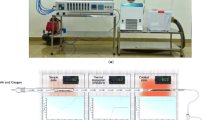Abstract
The goal of this work was to optimize the liquid scintillation counting techniques for the determination of14C in stack effluent gases and in environmental samples such as biological and air samples. Carbon-14 activities in most environmental samples were measured with the direct CO2 absorption method. The highest figures of merit were found through the variation of Carbosorb E and Permafluor V ratio, and measurement windows. The best condition was an 1:1 volume ratio. Average 2.35 g of CO2 was reproducibly absorbed in the 20 ml mixture within 40 minutes. The counting efficiency determined by repeated analysis of NIST oxalic acid standard and the background count rate were measured to be 58.8±1.4% and 1.88±0.06 cpm, respectively, in case of saturated solution. The correction curves of counting efficiency for partially saturated solutions and for saturated solutions with quenching were prepared, respectively. The overall uncertainty of the sample specific activity for near background levels was estimated to be about 7% for 4 hours counting at 95% confidence level. Stack effluent gas samples were measured by a gel suspension counting method. After precipitation of CO2 in the form of BaCO3, 140 mg of which was mixed with 6 ml H2O and 12 ml of Instagel XF. The counting efficiency was measured to be 71.5±1.7% and the typical sensitivity of this technique was about 510 mBq/m3 for a 100 min count at a background count rate of 4.7 cpm. For the benzene counting method measurements were performed with a mixture of 3 ml benzene and 1 ml of scintillation cocktail (5 g of butyl-PBD in 100 ml of scintillation-grade toluene) in a low potassium 7 ml borosilicate glass vial. The counting efficiency and the background count rate were measured to be 64.3±1.0% and 0.51±0.05 cpm, respectively. The long-term stability of samples has been checked for all the counting techniques over a two week period, during which no apparent change in counting efficiency and background level was found.
Similar content being viewed by others
References
K. Pfeiffer, D. Rank, M. Rschurlovits, Intern. J. Appl. Radiation Isotopes, 32 (1981) 665.
R. M. Qureshi, R. Aravena, P. Fritz, R. Drimmie, Appl. Geochem., 4 (1989) 625.
R. R. Rao, R. W. D. Killey, Radiochim. Acta, 65 (1994) 63.
G. Rauret, J. S. Mestres, J. F. Garcia, Nucl. Instr. Meth., B34 (1988) 373.
H. Kawamura, N. Matsuoka, Y. Takashima, J. Radioanal. Nucl. Chem., 173 (1993) 323.
M. Tschurlovits, V. Rajner, D. Rank, Appl. Radiation Isotopes, 41 (1990) 891.
Author information
Authors and Affiliations
Rights and permissions
About this article
Cite this article
Woo, H.J., Chun, S.K., Cho, S.Y. et al. Optimization of liquid scintillation counting techniques for the determination of carbon-14 in environmental samples. J Radioanal Nucl Chem 239, 649–655 (1999). https://doi.org/10.1007/BF02349085
Received:
Issue Date:
DOI: https://doi.org/10.1007/BF02349085




